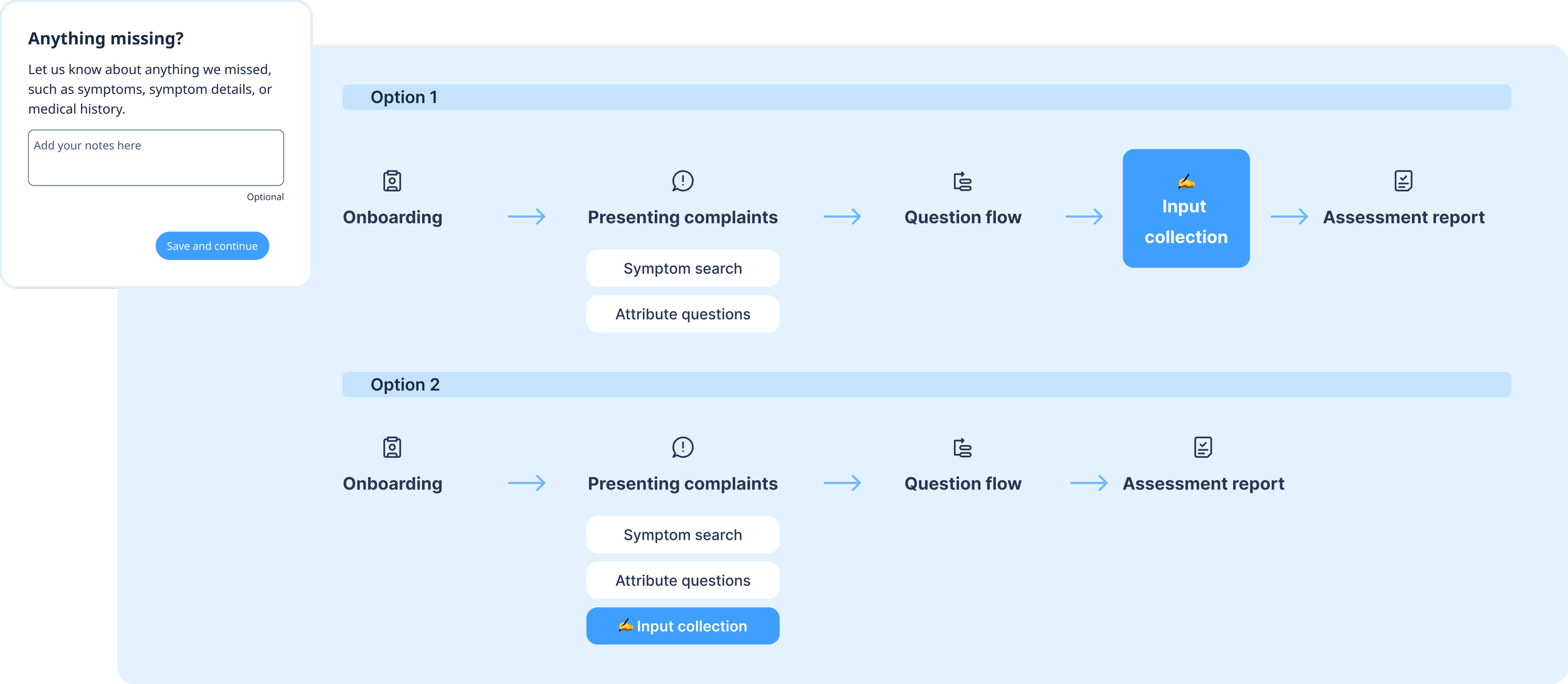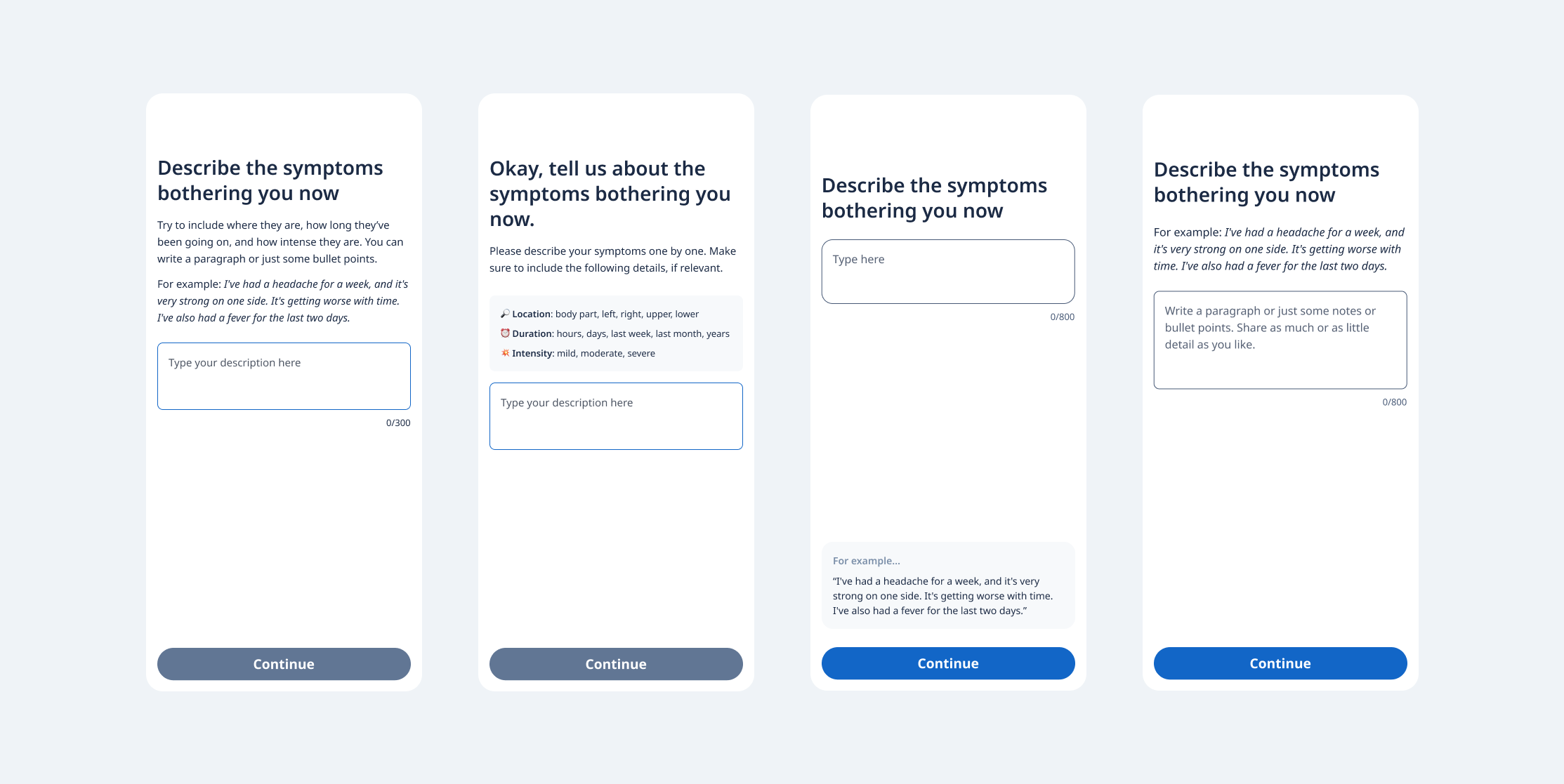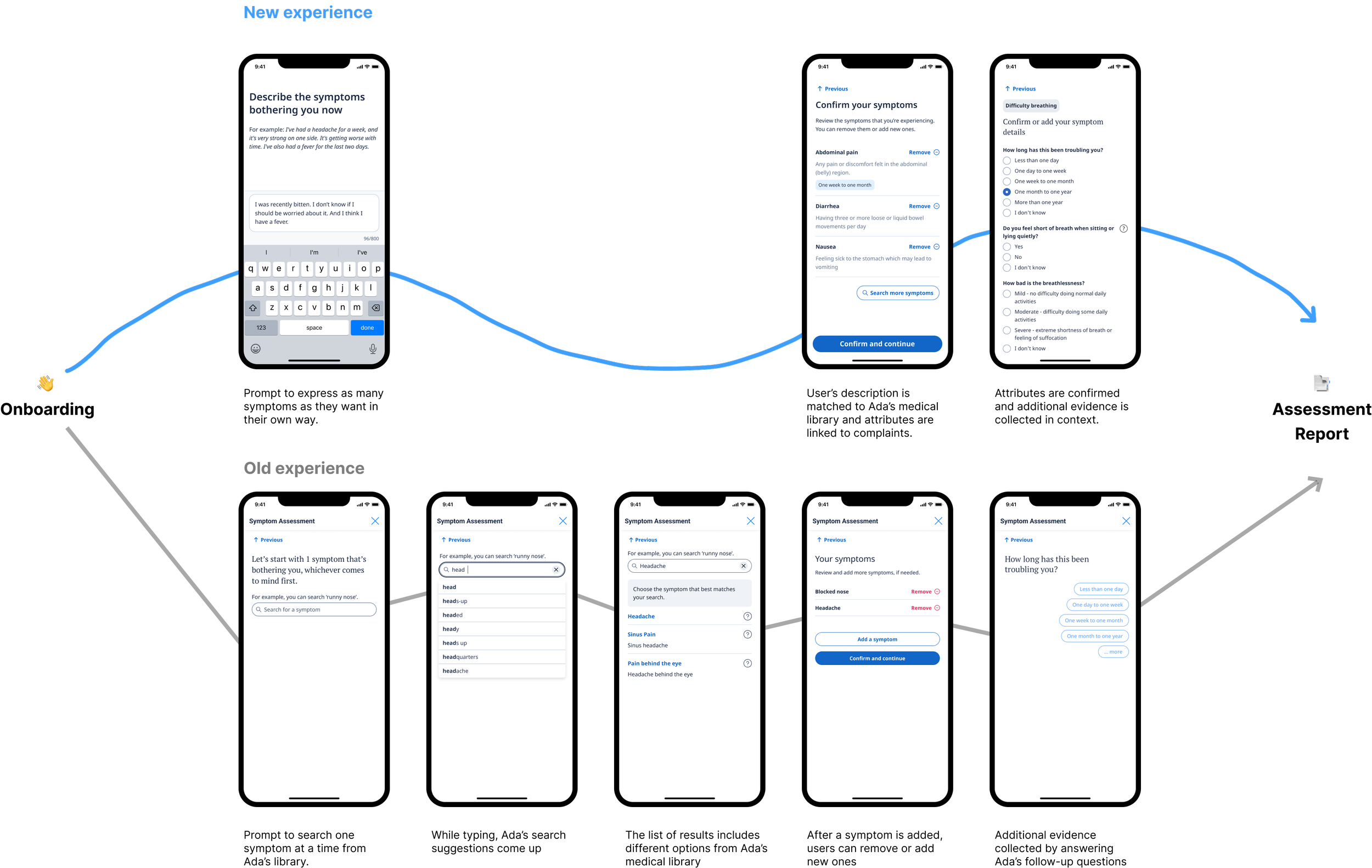Leveraging AI to help users understand and manage their symptoms
Ada Health · 2023-2025 · Senior Product Designer
Ada is a health app powered by clinically advanced AI that helps users better understand and manage their symptoms. It enables users to complete symptom assessments and receive potential explanations for their health concerns. Toward the end of 2023, we began exploring how Large Language Models (LLMs) and Generative AI could enhance the Ada experience.
In late 2023, I joined a newly formed working group focused on exploring how we could gather additional information to enhance the accuracy of our symptom search and overall user experience. Users frequently shared feedback that they couldn’t fully express their concerns, or that the process didn’t feel natural to them. By collecting richer inputs and integrating them with our existing capabilities, we saw an opportunity to make Ada more intuitive and responsive to user needs.
📣 “… you almost need to know what you have, for Ada to tell you what you have! (...)”
At the time, users could only add information to their assessment through the symptom search feature. They would enter a symptom into a search bar and select the most relevant option from our medical database. These presenting complaints would then be supplemented with additional evidence by answering Ada’s follow-up questions. However, this framework required users to adapt to Ada’s way of communicating, rather than allowing them to express themselves naturally.
Starting point
In the first two rounds of design and research, we explored where and how to collect additional user information. We developed two coded prototypes and conducted unmoderated tests. These early rounds focused primarily on the quality of the information gathered and its impact on diagnostic accuracy, rather than on user experience. We learned two key things: first, that the additional evidence did improve accuracy; and second, that the closer this input was collected to the symptom search moment, the higher the quality, and the more likely users were to share it.
Finding the right spot
This process led us to realise the key challenge wasn’t where we collected information, but how. We decided to replace the entire symptom search interface with a free-text input field, allowing users to describe their concerns in their own words. From there, we began iterating on how to effectively prompt users to share their cases in a detailed and meaningful way.
Given the scale of this change, we had to align closely with multiple teams, especially the one responsible for the existing symptom search experience.
After our fourth iteration, the Enterprise Leadership Team approved a plan to launch a version of the new experience on our own website in the following quarter. From that point on, we entered a fast-paced phase of design and implementation in which figuring out how the feature would work while it was being built (a bit like designing the car while already driving it).
What were the main challenges?
☝️ Finding the right balance between guidance and freedom
In each round of user research, we tested ways to let users share their symptoms in their own words: maximising the richness of the information we received while avoiding the risk of biasing their input. If we gave too much guidance, users tended to mirror our examples, limiting the variety and authenticity of what they shared.
We quickly realized that being overly prescriptive reduced the value of the input. Ultimately, we settled on providing a single, generic example that highlighted the key types of information we could currently process, striking a balance between encouraging detail and maintaining user freedom.
This was a major focus for the Research team because it directly impacted Ada’s accuracy and medical safety. Finding ways to clarify what users meant without adding complexity to their experience, proved to be a challenging balance.
I proactively explored and proposed multiple approaches to tackle this challenge, but due to technical constraints, real-time disambiguation wasn’t feasible at this stage. After carefully evaluating various design options, we made the strategic decision to launch without this feature for now, while actively monitoring and addressing any instances of user misunderstanding as they arise.
✌️ Disambiguation
👁️ Disambiguation is the process of clarifying and distinguishing between different meanings or interpretations of the symptoms a user describes, especially when their input is vague or imprecise. Effective disambiguation enhances both the accuracy of search and extraction results, as well as overall user satisfaction. It ensures that users are matched with the most appropriate Ada findings that reflect what they’re actually experiencing, even when their language is informal or unclear.
☘️ Validation for medical safety
This project introduced a fundamentally different approach to how Ada’s assessments worked, generating a lot of excitement and understandably, raising concerns about product safety given Ada’s status as a regulated medical device.
To address these concerns, we held regular workshops with our medical safety, legal, and research teams. This collaborative process ensured that all risks were carefully considered and mitigated, or that we reached compromises that balanced innovation with compliance and user safety.
A good example of this collaboration was our alignment with the legal department, who were concerned about the lack of safety mechanisms to prevent users from sharing personally identifiable information in their prompts. To address this, I organized a workshop with legal, user researchers, and copywriters to fully understand their concerns and plan for various scenarios. The outcome was a comprehensive proposal that gave everyone confidence in the safety measures we implemented.
We landed on an MVP approach that was ambitious yet evolving, and basically rescoped nearly every week. Explaining the entire journey to production would require a full case study on its own, but despite the challenges, we successfully delivered the feature. After a period of hypervigilance, here are the main highlights:
Overall, performance was impressive (not just my assessment, but praise directly from our medical team), which left us all optimistic about the feature’s potential and its implications for Ada’s future.
For the first time in a live Ada product, we captured the full context of users’ experiences right from the start of their assessment.
The free-text input field was used exactly as intended: users freely shared their health concerns in their own words. Some responses were short and concise, while others provided rich context. Overall, the density and quality of information were impressively high.
Learnings and takeaways
Working with LLMs in a heavily regulated industry (with hypervigilant stakeholders and starting from scratch) was challenging. I learned to embrace compromise, focus on small wins, and accept that we couldn’t move fast and break things in this context.
Not every team fully understands product strategy, user experience, or the value of user research, and that’s okay. Investing time to educate stakeholders and communicating UX and UXR methodologies clearly is key to alignment.
Figuring out where to collect additional user input was a pivotal moment. We shifted from enriching input to fully replacing it, a major product change that required strong buy-in from Product Leadership. They approved launching an MVP in a controlled environment.
I learned to balance exploring creative solutions with keeping stakeholders engaged: proposing feasible, reassuring options that wouldn’t overwhelm or scare people off. This often meant accepting simpler solutions initially, with plans to revisit and improve later.
After announcing the MVP launch, I sometimes had to hold back my creativity to work within the constraints of existing products and components while still driving progress.
My role in this project
Led design efforts for research, experimenting with and leveraging LLMs and Generative AI within Ada’s products to enhance performance and accuracy through aesthetically compelling and functionally effective design solutions.
Advocated for thoughtful, user-centered design decisions by confidently addressing stakeholder concerns and ensuring alignment.
Drove innovation by challenging the status quo and proposing bold, creative solutions to complex problems.
Collaborated closely with the user research team to identify research opportunities, generate insights, and develop hypotheses for effective solution implementation.
Represented product design in client engagements and contributed to strategic decision-making alongside product and design leadership.
Worked hand-in-hand with engineering teams to ensure seamless translation of design into the final product.
Contributed to the continuous improvement of Ada’s Design System, ensuring consistency, scalability, and strong visual design across the product.







